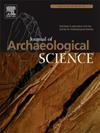Decoding hunter-gatherer-knowledge and selective choice of lithic raw materials during the Middle and Later Stone Age in Eswatini
IF 2.6
1区 地球科学
Q1 ANTHROPOLOGY
引用次数: 0
Abstract
Reconstructing past movement and mobility patterns requires a landscape-scale approach with knowledge of potential raw material sources and, ideally, multiple archaeological sites. Building on legacy collections in the Lobamba Museum in Eswatini and the identification of primary lithic raw material outcrops through landscape survey, we can provide scenarios of raw material provisioning for hunter-gatherers in Eswatini over the past 40 000 years. We used Neutron Activation Analysis (NAA) to refine the terminology as the three ‘chert’ varieties from the archaeological sites Hlalakahle, Siphiso, Sibebe and Nkambeni are more precisely described as red jasper, green chalcedony and black chert. We were able to identify the primary outcrops for both red jasper and the green chalcedony. Using a least cost path (LCP) analysis together with hydrological and geomorphometric estimates of clast transport in relevant rivers, we reconstructed potential transportation routes of raw material and infer likely provisioning scenarios. During the final Middle Stone Age (MSA), red jasper occurs rarely or is absent in archaeological assemblages, while green chalcedony and other chert variants are frequently observed. This is despite the source of red jasper occurring near the green chalcedony outcrop. During the Later Stone Age (LSA), the red jasper, and a red chert variant of unknown provenance appear more frequently, indicating different raw material provisioning choices.
破解斯瓦蒂尼中晚期石器时代的狩猎-采集知识和石器原料的选择性选择
重建过去的运动和移动模式需要一种景观尺度的方法,了解潜在的原材料来源,理想情况下,还需要多个考古遗址。基于斯瓦蒂尼洛班巴博物馆的遗产收藏,以及通过景观调查确定的主要石器原料露头,我们可以为斯瓦蒂尼过去4万年的狩猎采采者提供原材料的场景。我们使用中子活化分析(NAA)来完善术语,因为来自考古遗址halakahle, Siphiso, Sibebe和Nkambeni的三种“燧石”品种更准确地描述为红色碧玉,绿色玉髓和黑色燧石。我们能够识别出红色碧玉和绿色玉髓的主要露头。利用最小成本路径(LCP)分析以及相关河流中碎屑运输的水文和地貌估算,我们重建了原材料的潜在运输路线,并推断了可能的供应情景。在最后的中石器时代(MSA),红色碧玉很少出现或在考古组合中不存在,而绿色玉髓和其他燧石变体经常被观察到。尽管红色碧玉的来源出现在绿色玉髓露头附近。在晚石器时代(LSA),红碧玉和一种来源不明的红燧石变体出现得更频繁,表明不同的原料供应选择。
本文章由计算机程序翻译,如有差异,请以英文原文为准。
求助全文
约1分钟内获得全文
求助全文
来源期刊

Journal of Archaeological Science
地学-地球科学综合
CiteScore
6.10
自引率
7.10%
发文量
112
审稿时长
49 days
期刊介绍:
The Journal of Archaeological Science is aimed at archaeologists and scientists with particular interests in advancing the development and application of scientific techniques and methodologies to all areas of archaeology. This established monthly journal publishes focus articles, original research papers and major review articles, of wide archaeological significance. The journal provides an international forum for archaeologists and scientists from widely different scientific backgrounds who share a common interest in developing and applying scientific methods to inform major debates through improving the quality and reliability of scientific information derived from archaeological research.
 求助内容:
求助内容: 应助结果提醒方式:
应助结果提醒方式:


